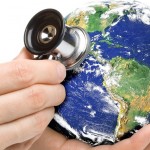 Headlines trumpet the perils of climate change. We are warned that the seas are rising, polar ice caps melting, habitats are eroding and storms worsening. Even as many express earnest concern for imminent potential consequences of climate change, there is still contentious debate about its causes and whether man is its direct agent. Expensive responses are urged, but it is uncertain whether any such measures or radically changing our lifestyles by a hurried shift to renewable energy sources will realistically affect trends.
Headlines trumpet the perils of climate change. We are warned that the seas are rising, polar ice caps melting, habitats are eroding and storms worsening. Even as many express earnest concern for imminent potential consequences of climate change, there is still contentious debate about its causes and whether man is its direct agent. Expensive responses are urged, but it is uncertain whether any such measures or radically changing our lifestyles by a hurried shift to renewable energy sources will realistically affect trends.
However, there is a path that breaches all conflicting opinions and will yield consequential benefits no matter the level of climate urgency or cause. That approach is through the appropriate recognition that any shift in pattern and distribution of infectious disease is the single greatest repercussion of any alteration in climate. This most critical variable is the final common denominator affecting our own lives and the well-being of all other creatures on this planet. Yet surprisingly, this factor receives scant attention.
Microbial pathogens thrive in all ecologies. Any deviation in pattern of humidity or temperature alters the distribution and potential virulence of our microbial companions. Shifts in the distribution of vegetation in turn directly modifies the dispersal and range of animal predators or their prey. These interrelationships can have far-reaching impacts on our intimate relationship with the microbial realm. In particular, many infectious diseases are spread by specific strains of vectoring insects or other disease-carrying organisms, such as rodents. Changes in their pattern of behavior and distribution can influence the transmission of pathogens or their relative abundance.
Some of these changes are believed to be currently observed. For example, malaria is spreading to the highlands in Africa from its prior predominant lowland distribution. A northward sweep of West Nile virus in the United States has been linked to the changing distribution of disease carrying mosquitoes. Climate change has been implicated in both these instances.
Modern technology has granted us the privilege of nearly instantaneous travel across the globe and transit to previously undisturbed habitats. Pathogens thrive in all of these complex and diverse ecologies. Consequently, even once relatively obscure diseases are now being granted a larger global range. Chikungunya is a viral disease spread by mosquitoes. It was first identified in Africa 60 years ago and previously confined to that continent. Only recently, several thousand cases have been identified in the Western Hemisphere, particularly in the Caribbean. Travelers and their contacts are now being afflicted and it has only recently been diagnosed in the mainland U.S. The symptoms include severe and disabling joint pain, and there is no known cure. In a similar manner, dengue fever is spreading beyond the boundaries of former endemic areas. Moreover, a wide range of diseases can be transmitted to humans from animals, such as swine flu. Shifting climate may enhance the likelihood of that cross transmission or the virulence of any microbial strains that do so.
Although less generally considered, as humans, we are not just victims. Recent research has revealed that our association with microbial life is much more profound than previously understood. Humans harbor ten times as many microbial cells as our own innate cells and we are carriers of vast numbers of pathogens too. Spread of these microbes from humans to other animals, such as antibiotic resistant staphylococcus from human owners to dogs, and sporadic cases of poultry epidemics instigated by human disease carriers are well documented. Nor is this believed to be a new phenomenon. The loss of the North American large mammals 12,000 years ago, like the woolly mammoth and saber-toothed tiger, has been correlated by some researchers to a prior human migration. It is suspected that man or domesticated animals such as hunting dogs were the unwitting carriers of novel pathogens. These were then brought to the New World from the Old when humans crossed the Siberian land bridge for the first time in that ancient era. The result was the unintended devastation and extinction of the large indigenous mammals exposed to a variety of unfamiliar aggressive microbial pathogens to which the large indigenous mammals lacked immunity.
So, the globe is interconnected as never before. In any ecosystem, whether on land or in water, if the balance of immunological accommodation is disturbed, far-reaching health consequences can supervene. There may be unexpected outcroppings of old pathogens or susceptibility to new ones. More virulent infectious diseases or novel ones can emerge when immunological defenses are unprepared. Long quiescent plagues could resurface. So, a changing climate carries many potential destructive risks.
How then should this affect our global response to climate issues? First, an increased awareness of the intricacy of the connections between climate change and infectious disease is necessary. Further, there should be redirection of a significant proportion of our limited resources for climate remediation towards infectious disease research and interdiction. That would include assessment tools to more accurately predict patterns of infectious disease and a particularly vigorous search for vaccines and other cures. Discovering new methods to restrict populations of mosquitoes, tics, other insect vectors or rodents would be of paramount importance. Simple and inexpensive life-saving procedures are already well known and tested for efficacy. Increasing the availability and distribution of mosquito netting and eradication of standing pools of water in areas in which mosquitoes breed could be implemented on a global scale.
Source: The Washington Times

















